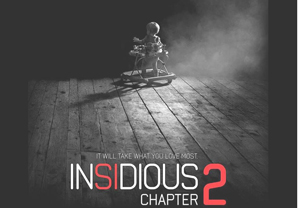Horror films, which are always part of Hollywood’s ecosystem, are suddenly very hot. The $5 million production of “Insidious: Chapter 2” rolled up about $41 million in domestic box office on its opening weekend of Sept 13-15 for distributor FilmDistrict.

“The success of the genre has upended a release calendar that once relegated horror movies to the winter months and Halloween season, proving they can compete with summer spectacles and break out of the traditionally quiet September,” says a “Wall Street Journal” article by Erich Schwartzel.
“Horror films are the best investments studios can make,” enthuses a “Forbes” magazine article by Dorothy Pomerantz. “Even when they’re not remakes of a popular brand, they can still be made on the cheap and attract enough fans to earn money.”
The Forbes article continues: “People who love horror almost don’t care what the film is about or who the stars are, they care about the scares. Last year’s ‘The Devil Inside’ cost only $1 million to produce and earned $100 million at the global box office. ‘Sinister’ cost $3 million and brought in $77 million and ‘House at the End of the Street’ cost $10 million and earned $40 million.”
Says the Wall Street Journal article: “The low-budget, high-return formula is most closely associated with Blumhouse Productions, the company behind the ‘Paranormal Activity’ and ‘Insidious’ franchises, and also ‘The Purge,’ a summer release from Universal Pictures that grossed $64.5 million domestically on a $3 million budget. The company’s next movie, ‘Paranormal Activity: The Marked Ones,’ is a Latino-focused spinoff of the blockbuster franchise due in January.”
Horror films are a staple of the indie-sector and the majors add some to their release schedules too. The book “Marketing to Moviegoers: Third Edition” notes that a large number of such films are made on speculation—meaning financed with no assured distribution–and many do not later get theatrical distribution. Some don’t even get meaningful video-on-demand. The reason usually is that the film turned out poorly.
With all the enthusiasm about box office success, don’t forget that horror films tend to play off fast—meaning their box office trails off rapidly. Also, their values in aftermarkets like DVDs and TV are less than less-audience-restrictive films with comparable cinema box office.
The edgy horror film had an earlier and longer crest from the 1960s to 1970s, when independent film companies churned out scary films with cheesy movie marketing. “A favorite visual shows a pretty but alarmed young woman who is bound in a spread-eagle position, which projects both horror and a subtle suggestion of kinky sex,” notes “Marketing to Moviegoers” of this bygone era. “‘It’s an orgy of terror,’ one trailer voice-over enthusiastically informs.”
Hollywood always experiences cycles and horror is at the top…for now.
Related content:
Leave a Reply